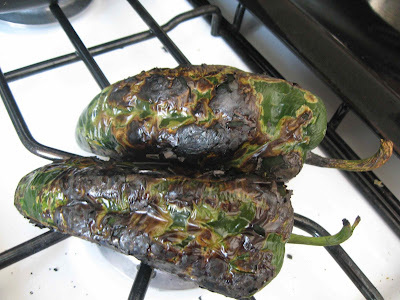
Huevos a la mexicana con frijoles
I love breakfast food. Perfectly crispy hashbrowns, smoky bacon, fresh eggs… mmm. Or French toast or pancakes with maple syrup, also mmm… While I sometimes have a hankering for an American breakfast that I can only satisfy at home here in Puebla (restaurants here just don’t do hashbrowns, French toast, or pancakes well at all), I LOVE a good Mexican breakfast. Breakfast dishes here in central Mexico are essentially a dozen different ways to combine eggs, tortillas, and salsas with a side of delicious beans.
You don’t really need a recipe for most of these, so what I figured I would do is run through a list of some of my favorites just to give you ideas for a weekend breakfast or even a midnight snack. If you have some salsa on hand (hopefully that you made yourself!), eggs, and tortillas (corn or flour), you’re already more than halfway there. Be aware that the amount of salsa in a Mexican breakfast can be high. Even if you keep it mild, it’s still a lot of acid. Can be a bit much if you’re not used to it, but once you get used to it, you will crave it in the morning. So here it goes. Pick your favorite, put your spin on it, make sure you have some beans on the side, and enjoy!
Here are a few different versions of scrambled eggs:
Huevos a la mexicana: These are scrambled eggs with tomato, onion, and chile (usually Serrano or jalapeño) to reflect the colors of the Mexican flag. Restaurants sometimes just toss some pico de gallo in scrambled eggs and call it good. I prefer the way my mother-in-law makes them (she doesn’t cook much, but her huevos a la mexicana are perfect). Basically, the key is to cook the tomato like crazy and use a fair amount, one roma tomato per egg. Heat some oil, add the chopped tomato with a little onion, and sautee it over medium-high heat for 5-10 minutes, or until the tomato starts to brown. Add as much or as little diced chile as you like, cook for a minute, then add your beaten eggs and cook however you like ‘em. With the tomatoes almost caramelized, you end up with sweet and spicy. Perfect.
Huevos con tocino, jamón o chorizo: Fry up either a little chopped bacon, ham, or chorizo, then throw your beaten egg in and scramble. Great on a warm flour tortilla with a little Tabasco sauce.
Huevos al albañil: Heat up either green or red salsa, scramble your eggs, then dump them into the hot salsa. They should be thoroughly bathed in the salsa.
Here are a few different versions of eggs sunny-side up or over-easy:
Huevos rancheros: Red salsa is the most traditional for this, but if you have green, go for it. Heat a little oil in a pan, quickly fry two tortillas (corn or flour), set them aside, and then cook your eggs as desired. Place one egg on top of each tortilla, then pour warmed salsa over the top. If you have it, add a little shredded cheese or cream. You can also add a slice of ham in between the tortilla and the egg. Classic.
Huevos divorciados: You need green and red salsa for this one. Basically, make huevos rancheros, but bathe one egg in green and the other in red. Makes for a slick presentation.
Huevo estrellado: If you’re not in the mood for a lot of salsa, just fry up your tortilla(s) and put your fried egg on top. It’s a nice alternative to toast.
And one of my all-time favorites at home or at a restaurant…
Chilaquiles: For chilaquiles, you need a far amount of either red or green salsa, and you need to make your own tortilla chips from corn tortillas (If you buy them, make sure they are chips made from actual tortillas and not flavored in any way. This dish won’t work with your run-of-the-mill commercial tortilla chips. They would fall apart and be too salty.). It’s really easy and a great use of stale tortillas. Cut them into little triangles (8 per tortilla) and fry them in batches in hot oil, draining them on paper as you remove them. Once your chips are ready, slice a little onion (1/4 of an onion or so), heat a tablespoon of oil in a large frying pan, fry the onion for a couple minutes, then dump in the salsa. Heat the salsa for a couple minutes, then add the chips to the pan and toss to coat. Once they are evenly coated and just starting to become a little more pliable, take them off the heat, plat them, and top with shredded cheese (cotija is excellent), sour cream, raw onion if you like, and avocado if you have it on hand. To really send this dish over the top, you can add a protein, like shredded chicken, a couple of fried eggs, or even a piece of skirt steak. Yeah, that's good.







